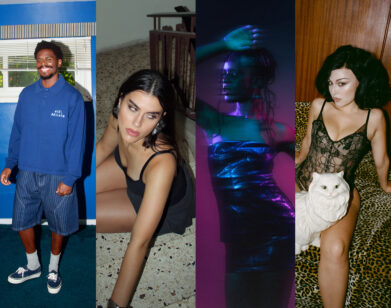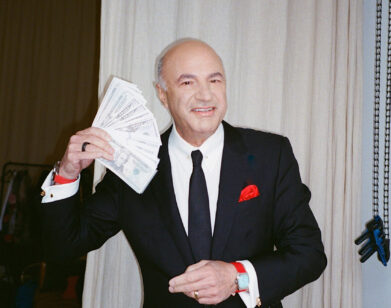Dean & Britta Go Pop
In 1966, Andy Warhol entertained a roomful of clinical psychiatrists in New York with his first multimedia performance of The Exploding Plastic Inevitable. Before an admittedly unlikely inaugural audience, the show combined a selection of Warhol’s screen tests with the hypnotic music of The Velvet Underground—which Warhol was introducing to the world. The artist matched the band’s shifty and moody songs with films of Bob Dylan, pop icon Nico, Edie Sedgwick, and Lou Reed, among other Factory regulars; their faces staring into audiences throughout cities in America were an early testament to Warhol’s preoccupation with the fragility of iconic personae.
Tomorrow night at The Metropolitan Museum of Art in New York, the musical duo Dean & Britta (Dean Wareham and Britta Phillips, plus their ensemble) will perform 13 Most Beautiful: Songs for Andy Warhol’s Screen Tests, their own enchanting original instrumental and vocal compositions, alongside 13 of Warhol’s four-minute film portraits.
Interview caught up with Wareham to talk about how the characters in Warhol’s life, frozen in their youth and beauty on screen, haunt and inspire Dean & Britta’s accompanying songs.
ANGELA LEDGERWOOD: Do you think you were approached by the Warhol Museum in Pittsburgh to be involved in this project because your bands, Galaxie 500 and Luna, have been likened to The Velvet Underground?
DEAN WAREHAM: Well obviously I’m a big fan, and they are an important band in the history of rock and roll. It’s hard to imagine David Bowie without them. It’s hard to imagine the whole punk movement without The Velvet Underground. I toured with them when they did their reunion tour, and no one sounds like that; they are a very unique-sounding band. They have a lot of noise, they have a viola, they have a drummer that’s standing up, certainly they have influenced my guitar playing, but hopefully after 12 records you start to sound like yourself.
In terms of the comparison when thinking about this project, each screen test is four minutes long, so I think they thought it would be good to get a songwriter instead of a straight film composer. The curator was a big Galaxie 500 and Luna fan, and we were so lucky to get this.
LEDGERWOOD: Did you get to pick the 13 screen tests that interested you?
WAREHAM: Yeah, we were given free reign to pick the 13.
LEDGERWOOD: Did you watch all 500 of them before deciding?
WAREHAM: I probably watched about 150. Not all of them were available, only about half of them had been transferred, so I went down to the museum in Pittsburgh and watched them in the video library there. It was pretty apparent which ones were good. Some people are good in front of the camera, some are not, and I guess that’s what a screen test means. I came home with about 40 of them and then started reading about that period, 1964 to ’66, and the people, and learned about them. We tried to pick 13 people who were at The Factory on a daily basis and who were involved in his [Warhol’s] life, more so than people who happened to slip through and do a screen test.
LEDGERWOOD: Each song feels like it has its own story, but of course the audience projects that onto the person on the screen in front of them…
WAREHAM: I think our job is to look at the films and figure out what the mood is.
LEDGERWOOD: Do you and Britta compose together?
WAREHAM: There’s no rule. We compose with our whole band. We put a friend’s song up against Edie Sedgwick’s face and it seemed to make sense somehow. You can’t write a song about exactly what is going on. You can have ideas about the music, but once you put the music up against the picture, the picture tells you if you’re slowing it down and making it more boring or of you’re speeding it up and making it more exciting.
LEDGERWOOD: The screen tests, in a sense, capture Warhol’s idea that everyone has their 15 minutes of fame, even a brief moment that’s not necessarily linked to talent.
WAREHAM: Maybe it’s easier to get that 15 minutes of fame now. I don’t know, it’s such a different age now. We are swamped with so much information, so many artists and so many bands. It’s a bit like the people in some of the films, like Paul America, they had their brief moment at The Factory and then they became, like, wasted human beings. Ondine [one of The factory regulars] said, “What comes after superstar? What comes after superstar?”—”Has-been.” [laughs] That’s true for some of those people anyway. This whole screen test show, there’s a sadness to it, because so many of these people died tragically. I stand on stage and look at Edie Sedgwick’s face and she just looks so sweet and naïve even though back then, even when she arrived at The Factory she was a mess. There’s a sadness to it. She died at age 28 of a drug overdose.
LEDGERWOOD: I love the title of the song you’ve put with her, “It Don’t Rain in Beverly Hills.”
WAREHAM: That’s the one I mentioned that our friend wrote, Jack Early, an artist who actually started writing songs. We met him at a party and he played a song, and we thought that might be right for Edie Sedgwick.
LEDGERWOOD: Has your relationship with these people on screen changed over the three years you’ve been performing the show?
WAREHAM: Certainly, I keep seeing things I haven’t noticed before. I think these films—it’s just people staring back at the camera, right, so your mind inevitably wonders, so I’m always seeing things I hadn’t seen before.
LEDGERWOOD: Yeah, great music taps into someplace in our brains…
WAREHAM: It taps into our emotions quicker than anything else and immediately take you places. Things you hear again from your childhood that you haven’t heard in a long time can make you cry; they have that power.
LEDGERWOOD: There’s an instrumental song called “Herringbone Tweed” played along with Dennis Hopper’s screen test that I found particularly moving; can you tell me about that?
WAREHAM: That was an old Luna instrumental song, and we reworked it while looking at Dennis Hopper’s picture. There’s a real shift in the screen test. He sits down and he’s very serious; you can tell he’s the only trained actor. He’s going through some deep Stanislavskian moment, he’s tapping into a tragic event, but then about two minutes into it, he starts giggling. I think something happens, because he looks to the side and starts bobbing his head and giggling. At this point he was out of work. It’s like, 1962…
LEDGERWOOD: He was banished from Hollywood, wasn’t he?
WAREHAM: He was banished for being impossible on a film set, but this was before that, this is pre-Easy Rider. He was an early supporter of Warhol. He was one of the first people to buy a soup can.
LEDGERWOOD: There’s also this other photographer, Billy Name, included in the performance.
WAREHAM: Yeah, he did the photos for the back of The Velvet Underground’s third album. I guess in this period Warhol had two main assistants; one was Gerard Malanga and the other was Billy Name. He had painted his own apartment on East Seventh Street in the summer of 1964 and Warhol got brought to this apartment, and Warhol said, “I really like this, can you come and do this at the new studio I’ve got on East 47th Street,” and that was The Factory. Billy Name moved up there, painted the whole thing silver, and started living there. He build himself a little area in the back and lived there for the next couple of years and was Warhol’s assistant—his arms and legs—that’s what he called himself. Warhol’s arms and legs. He didn’t get bitter later or try and take any of the credit for anything.
LEDGERWOOD: He was an extension of Warhol?
WAREHAM: Yeah, that’s how he saw himself. And he also became the unofficial Factory photographer. And he’s still alive and well.
LEDGERWOOD: One of the few.
WAREHAM: He was also Andy’s sometime boyfriend.
LEDGERWOOD: With your evolution from Galaxie 500, to Luna, to Dean and Britta, what’s next for you?
WAREHAM: Britta and I are both working on our own solo albums now. We both play on each other’s records.
LEDGERWOOD: When did you first hear Britta sing?
WAREHAM: It would have been shortly after she joined Luna, we started performing “Bonnie and Clyde,” a male/female duet which Luna had covered some years earlier.
LEDGERWOOD: And how long were you in the band together before the romance happened? When I look at the pictures of you two, I think, of course it was going to happen. [laughs]
WAREHAM: Not long. [laughs]
DEAN & BRITTA WILL PERFORM AT THE METROPOLITAN MUSEUM TOMORROW NIGHT. FOR MORE ON THE EVENT, CLICK HERE. FOR MORE ON DEAN & BRITTA, VISIT THEIR WEBSITE.







